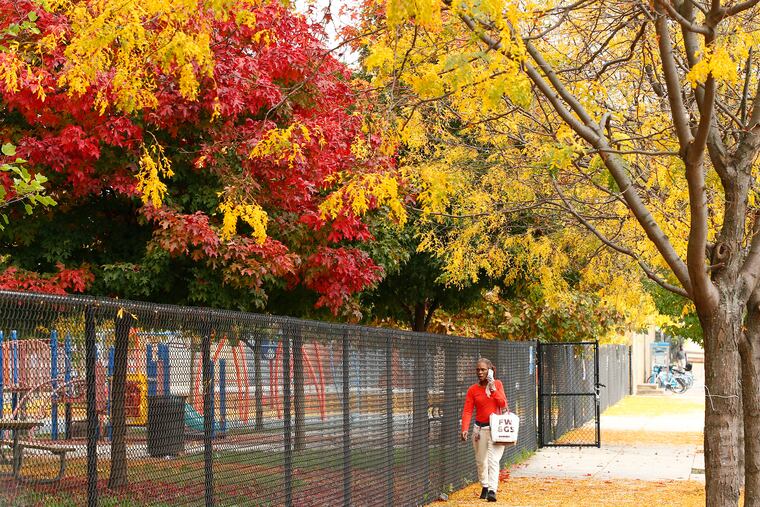Fred, Henri, and Ida might add color to foliage season around Philly and in the East
Expect peak foliage around here in late October. Go to New Hampshire for a head start.

Those tropical downpours might have been good for something after all.
Some veteran foliage trackers say thanks in part to all the moisture imported from the tropics by the remains of Fred, Henri, and Ida, that come delta variant or high water the annual foliage show will prevail and could persist into early November around the Philadelphia region.
The process has begun: First blushes appeared in northern New Hampshire on Aug. 9, the earliest in 47 years of tracking by the only people known to keep score, and the wave of color is rippling southward.
“You guys are in really good position through most of the Mid-Atlantic,” said Jim Salge, a meteorologist who is the foliage forecaster for Yankee Magazine, published out of southern New Hampshire. “I wasn’t as hopeful until all of a sudden all these tropical storms started coming through.”
» READ MORE: Where to see fall foliage in the Philly area
The nourishing rains should add splashes of intensity to the palette, agreed Ryan Reed, a forestry specialist with Pennsylvania’s Department of Conservation and Natural Resources, who plans to start posting the agency’s weekly foliage guide on Sept. 30. “Antecedent conditions are shaping up nicely for a beautiful fall foliage season in Pennsylvania,” he said.
Not as sanguine is Tyler Altenburger, arborist manager at Longwood Gardens in Kennett Square, the venue of over 6,000 deciduous trees. He said he is concerned that the tropical deluges might not have compensated for the summer’s hot and dry intervals.
That the leaves will take on the tints of the bounty of the season — the likes of apples, pumpkin, and squash — and that ultimately they will carpet the ground with their cinnamon-colored decay, is as certain as the fact that no one can predict with any certainty how vibrant the colors will be.
Among the seasons, says researcher Stephanie Spera, who is involved in a yearslong foliage-monitoring project, autumn is the scientific ugly duckling, “the most understudied.” In fact, for now the best source for leaf trends over the years might be a New Hampshire pancake parlor.
Why is this so hard?
The simple answer is that it’s all quite complicated. Leaf change is a nonlinear process, sometimes exhibiting behavior as baffling as the atmosphere’s.
This is primarily about light. And you might have noticed that we have been leaking light like crazy, with the days now about 50 minutes shorter than they were on Sept 1.
The trees sure have noticed. Responding to the light loss, the chlorophyll in the deciduous trees is giving it up. Ultimately, on the likes of the birches and oaks it will yield to the carotenoid pigments, the same ones that color pumpkins and corn; on the maples, to the anthocyanins that redden the apples.
But weather matters.
For best results, you want sufficient but not excessive rains in spring and summer, says Reed. This is a tricky balance. Too much rain, and the fungi will thrive; too little, and the leaf-killing moths will have a field day.
Reed and Salge, former meteorologist at the Mount Washington Observatory, concur that rain conditions have been favorable.
From here on out, the experts say, you would want generally dry days and cool nights without killer frosts, and this raises a few red flags.
The extended outlooks aren’t promising: The government’s forecast for the next six weeks is calling for above-normal temperatures in the East. (Then again, the atmosphere tends not to consult these things.)
And a larger question remains about whether worldwide warming is somehow delaying, dampening, or prolonging the foliage season.
Is climate change changing the season?
Spera, an assistant professor at the University of Richmond, began pursuing that question in 2019, tracking the timing of the seasons at Acadia National Park in Maine.
» READ MORE: Ida’s fatal power didn’t shock scientists who study how climate change primed the pump
But based on what she has been able to piece together from newspaper accounts and other sources, the peak foliage period in Acadia is arriving about a week later than it did in 1950.
Similarly, Reed has seen later peak onsets in Pennsylvania, but no “appreciable change” in the length of the season.
Spera said the lack of archival data has been a profound obstacle, and satellite data has serious limits; for example, clouds get in the way.
Evidently no one in the nation has been seriously charting foliage seasons — save for the owners of Polly’s Pancake Parlor, a wildly popular tourist attraction in Sugar Hill, N.H., who have diligently charted changes since 1975.
Polly’s owner Emily Cote acknowledges that the chart is more art than science and based on observations by her and her mother, Kathie. Kathie’s mother started the tradition in 1975 for business reasons: Foliage season is huge for Polly’s.
“Their historical record is really unparalleled,” said Salge, the foliage forecaster at Yankee Magazine.
But based on the latest chart, it would be hard to draw conclusions about timing. It showed that peak period arrived notably later than usual from 2015 to 2018, but came significantly earlier the last two years. And the 2021 “leaves starting” date was Aug. 9, the earliest ever.
When is it our turn?
Recent trends argue for a late October peak in the Philadelphia region. That is also the peak period projected by the smokymountains.com site.
The timing will be subject to the vagaries of the weather, which would include thunderstorm winds and unmentionable tropical storm remnants.
» READ MORE: See the aftermath of Ida's remnants passing over the Philadelphia region
In the meantime, as for visual hors d’oeuvres, enjoy the sunsets. With the sun’s light becoming ever more oblique, expect sunset colors to rival those of the leaves at peak time.